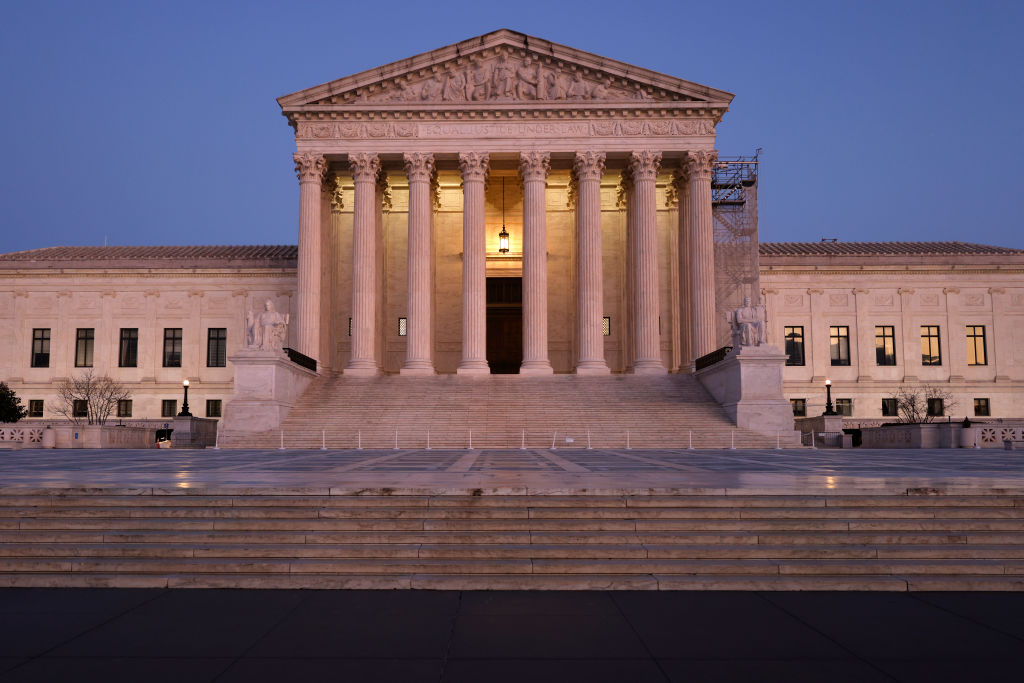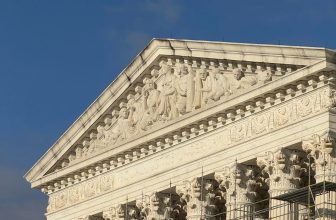
Texas came to the Supreme Court on Friday, asking the justices to clear the way for it to use a new congressional map intended to increase the chances that Republicans can retain control of the U.S. House of Representatives. On Tuesday, by a vote of 2-1, a three-judge district court in Texas barred the state from using the map in the 2026 elections, concluding that the map unconstitutionally sorts voters based on race. Texas Solicitor General William Peterson urged the court to pause that ruling, telling it that “[t]he confusion sown by the district court’s eleventh-hour injunction poses a very real risk of preventing candidates from being placed on the ballot and may well call into question the integrity of the upcoming election.”
Peterson asked the justices to put the three-judge district court’s ruling on hold by Dec. 1; he also asked the court to issue an order, known as an administrative stay, that would temporarily pause the ruling to give the justices time to consider the state’s request. In an order distributed shortly after 7:30 p.m. EST on Friday night, Justice Samuel Alito – who fields emergency requests from the 5th Circuit, which includes Texas – granted the administrative stay and instructed the challengers to file their response by 5 p.m. EST on Monday, Nov. 24.
The dispute has its roots in a call from President Donald Trump earlier this year for Texas to redraw its congressional map to create five additional districts favorable to Republicans. Republicans currently hold a narrow majority in the House: 219 to 214, with two vacant seats. As described by the Brookings Institution, in 20 of the past 22 midterm elections, the president’s party has lost seats in the House.
According to a story in The New York Times, lawmakers in Texas were wary of the president’s request to create new Republican districts. They feared that moving Republican voters from “safe” Republican districts to Democratic districts could jeopardize Republican incumbents in the districts from which those voters were transferred.
But on July 7, the head of the civil rights division at the Department of Justice, Harmeet Dhillon, sent the state a letter in which she asserted that four of the state’s districts were unconstitutional because they were “coalition districts” – majority-minority districts in which there was no one racial majority. Dhillon told the state that if it didn’t redraw these districts immediately, DOJ would take legal action.
On July 9, Texas Gov. Greg Abbott put redistricting on the agenda for a special session of the state’s Legislature. He instructed legislators to draw a new congressional map that would address the concerns mentioned in Dhillon’s letter.
In August, Texas adopted a new congressional map. Republicans currently hold 25 of the state’s 38 seats in the House of Representatives; under the new map, they hoped to win up to 30 of those 38 seats.
Even before Texas Gov. Greg Abbott signed the bill enacting the new map, six different groups of plaintiffs (led by the League of United Latin American Citizens, a civil rights group) went to federal court to challenge the map. They argued that it was the product of unconstitutional racial gerrymandering, and they asked a three-judge district court – which under federal law hears challenges to the constitutionality of the apportionment of congressional districts – to temporarily block the state from using the map for the 2026 elections.
The state defended the new map, arguing that it was enacted purely for political and partisan, rather than racial, reasons – and in particular, in response to Trump’s demand for five new Republican seats in the House of Representatives.
On Nov. 18, U.S. District Judge Jeffrey Brown, a Trump appointee, blocked the state from using the 2025 map and ordered the state to use the map that the Texas Legislature adopted in 2021 for the 2026 midterm elections. In a 160-page opinion joined by Senior U.S. District Judge David Guaderrama, Brown acknowledged that “politics played a role in drawing the 2025 Map. But,” he wrote, “it was much more than just politics. Substantial evidence shows that Texas racially gerrymandered the 2025 Map.”
Brown cited Dhillon’s July 7 letter to the state and called her assertion that the “coalition” districts violate the Constitution “legally incorrect.” “Far from seeking to ‘rectify . . . racial gerrymandering,’” he wrote, the letter “urges Texas to inject racial considerations into what Texas insists was a race-blind process.” And indeed, Brown continued, Abbott “explicitly directed the Legislature to redistrict based on race. In press appearances, the Governor plainly and expressly disavowed any partisan objective and instead repeatedly stated that his goal was to eliminate coalition districts and create new majority-Hispanic districts.”
Brown also contended that the Purcell principle – the idea that courts should generally not change election rules shortly before an election – did not preclude him from blocking the new map. The Purcell principle, he wrote, is “not just about counting the number of days until the next election” but instead “sets a flexible standard based on a fact-intensive analysis that considers the disruption an injunction would cause.” In this case, he said, barring Texas from implementing the new map “would not cause significant disruption” because “we are still one year out from the general election and four months out from the primary election.” Moreover, he observed, Texas “is still operating under the 2021 Map” – and will even hold a run-off for a special election in late January next year using that map.
In a 104-page dissent filed on Wednesday, Judge Jerry Smith of the U.S. Court of Appeals for the 5th Circuit was sharply critical of both the majority’s opinion and of Brown personally, describing Brown’s conduct as “the most outrageous … by a judge that I have ever encountered in a case in which I have been involved.” Brown, Smith contended, had failed to give him “any reasonable opportunity to respond” to his opinion before it was filed.
Turning to the substance of Brown’s opinion, Smith called it “the most blatant exercise of judicial activism that I have ever witnessed.” “Because the ‘obvious reason’ for the 2025 redistricting ‘of course, is partisan gain,’” Smith contended, “Judge Brown commits grave error in concluding that the Texas Legislature is more bigoted than political.”
In its 40-page filing on Friday night, the state told the court that the majority’s order “comes far too late in the day under Purcell” because the deadline for candidates to file for election, Dec. 8, is just 17 days away. In other cases, the state emphasized, the Supreme Court has relied on Purcell to block preliminary injunctions when primary elections were five or six months away; Texas, the state noted, will hold its primary election on March 3, 2026, “with early voting beginning on February 17, 2026, less than three months from now. Changing the primary date could be ‘catastrophically bad.’” Moreover, the state continued, “[t]he district court’s remedy compounds its Purcell error”: It should have given the Legislature a chance to come up with a new map of its own, rather than ordering the state to use the 2021 map, which the Legislature had repealed.
Even putting Purcell aside, the state wrote, the Supreme Court should also pause the three-judge district court’s order because all of the factors that the justices consider when deciding whether to grant temporary relief are met in this case. First, the state is likely to prevail on the merits of the dispute because the lower court’s ruling is inconsistent with the Supreme Court’s 2024 decision in Alexander v. South Carolina State Conference of the NAACP, in which a majority rejected the lower court’s conclusion that the state’s Republican-controlled Legislature had improperly relied too heavily on race in drawing the challenged district. Among other things, the state said, the challengers in this case had not submitted their own map, showing that a Legislature could have drawn a different map that achieved the state’s goals but without relying so heavily on race – “a mistake that this Court already held ‘would be clear error.’” Second, the state wrote, the challengers will not be harmed if the 2026 elections take place under the new map because that map is “‘the status quo’ on which counties, candidates, and voters have been relying.” By contrast, “the last-minute disruption to state election procedures—and resulting candidate and voter confusion—demonstrates both the irreparable harm that the [district court’s] preliminary injunction will cause” the state “and that the public interest overwhelmingly favors a stay and reversion to the 2025 maps.”
The state asked the justices to treat its application as its appeal from the majority’s ruling and to allow the case to “proceed directly to merits briefing.” The Supreme Court, it noted, “has done so in the redistricting context so that election litigation does not continue longer than necessary.”
Cases: Abbott v. League of United Latin American Citizens
Recommended Citation:
Amy Howe,
Texas asks Supreme Court to allow it to use redistricting map struck by lower court as racially discriminatory,
SCOTUSblog (Nov. 21, 2025, 8:06 PM),
https://www.scotusblog.com/2025/11/texas-asks-supreme-court-to-allow-it-to-use-redistricting-map-struck-by-lower-court-as-racially-discriminatory/






